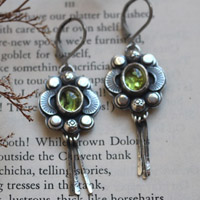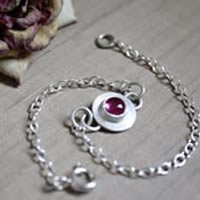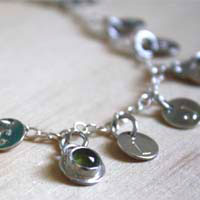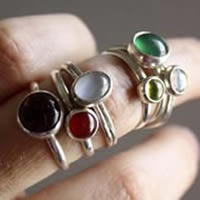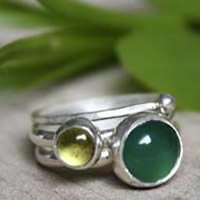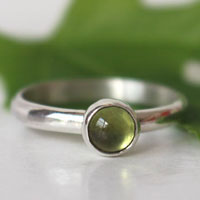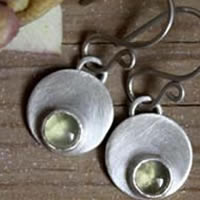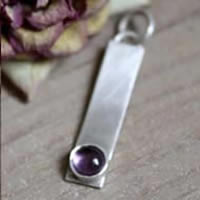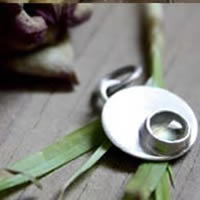- Jewelry
- Inspiration
- Good Deals
- Paintings
- About
- Contact
JEWELRY
- Anklet
- Bracelets
- Brooches
- Cufflinks
- Earrings
- Pendants & Necklaces
- Rings
- Draw your jewelry
- GOOD DEALS
- How to clean your jewel
- Metal we used
INSPIRATION
Peridot: history, healing properties and lithotherapy

Peridot properties

The name peridot originates from the Arabic word faridat, which literally translates to "precious stone," and from olivine, derived from the Latin olivus, referring to its characteristic olive-green hue. It belongs to the silicate family and more specifically to the nesosilicate group, where it is classified as a gem variety of olivine.
Composed primarily of magnesium (Mg₂SiO₄) and iron (Fe₂SiO₄), peridot owes its green color to the variable proportion of iron it contains, as well as the possible presence of trace elements such as nickel or chromium. Unlike other gemstones, its color is intrinsic to its chemical composition and does not result from impurities. This explains why peridot only occurs in shades of green, ranging from yellowish-green to deep olive-green.
Peridot is often mistaken for emerald due to their similar color, but it differs in both chemical composition and crystal structure. It has a vitreous luster and remarkable transparency that intensifies under artificial light, earning it evocative nicknames such as "the evening emerald" or "the poor man’s emerald." The terms chrysolite and olivine are sometimes used to refer to this gemstone, though chrysolite historically designated various yellowish or greenish stones in antiquity.
Peridots form under specific geological conditions, mainly in ultramafic igneous rocks such as peridotites and basalts. They are also found in the nodules of certain volcanic lavas, particularly in Hawaii, where peridot crystals sometimes break free from lava flows, creating green sand beaches.
One fascinating characteristic of peridot is its occasional extraterrestrial origin. Certain meteorites, known as pallasites, contain well-crystallized peridot inclusions, making it one of the few gemstones with both terrestrial and cosmic provenance. These meteorite peridots are extremely rare and highly sought after by collectors.
High-quality specimens exceeding 8 carats are particularly prized in jewelry and private collections. Among the most famous peridots, the American Museum of Natural History in New York and the Field Museum in Chicago exhibit exceptional specimens. The Smithsonian Institution in Washington, D.C., houses a rare 310-carat peridot, showcasing the beauty and rarity of this precious gemstone.
Peridot has a hardness of 6.5 to 7 on the Mohs scale, making it relatively resistant to scratches, though more fragile than gemstones like sapphire or diamond. This moderate hardness means that peridot can be used in jewelry, but requires some care, particularly for rings and bracelets, which are more exposed to impacts than pendants or earrings.
History, legends and beliefs about peridot
Peridot, nicknamed the "stone of the sun" by the ancient Egyptians, has always been surrounded by a mystical aura. Used in the adornments of ancient Greece and nomadic tribes, it symbolized light, vitality, and inner strength. This association with light and the divine explains why peridot was often used in religious and royal ornaments.
Peridot gained popularity around 1500 BCE, when the Egyptians began mining it on Zabargad Island (now Saint John’s Island), located in the Red Sea, approximately 80 km off the Egyptian coast. The pharaohs considered this gemstone sacred, and its extraction was strictly controlled: the mines were heavily guarded, and any intruder faced execution.
Traditionally, peridot mining was carried out at night, as it was believed that its glow was easier to detect under the light of torches and the moon. Miners would mark the locations of the stones before retrieving them at dawn.
A legend suggests that Cleopatra, a great admirer of gemstones, owned a collection of jewels adorned with emeralds, which were later discovered to be peridots. This confusion between peridot and emerald was common throughout history due to peridot’s vivid green hue and the difficulty in distinguishing the two before the advent of modern gemology.
During the reign of the Ottoman sultans, from the 14th century to the early 20th century, the largest known collection of peridots was assembled. These rulers highly valued the stone, associating it with divine protection and power. Many Ottoman jewelry pieces, now exhibited at Topkapi Palace in Istanbul, feature stunning peridots set in finely crafted gold.
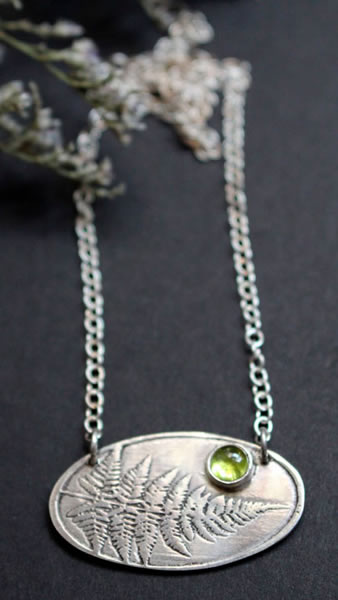
After the Crusades, peridots were introduced to Europe by the returning crusaders, who brought them back from the Holy Land. They were widely used in religious decoration, especially to adorn churches and sacred treasures. A famous example is the large peridot in the Shrine of the Three Kings in Cologne Cathedral, which was long mistaken for an emerald.
The Hawaiians believed peridot to be the sacred tears of the goddess Pele, the deity of volcanoes and fire. According to legend, these precious gems were shed in anger or sorrow during volcanic eruptions, reinforcing the idea that peridot had a deep connection to the elemental forces of nature.
In the Bible, peridot is mentioned among the twelve stones adorning the breastplate of the high priest Aaron, symbolizing the twelve tribes of Israel. It is also cited as one of the precious stones decorating the twelve gates of the Heavenly Jerusalem in the Book of Revelation, where it represents purity and divine protection.
In popular belief, peridot was thought to ward off "night terrors" and protect its wearer from negative influences. According to an ancient tradition, mounting peridot in gold was said to enhance its protective powers. Another belief held that wearing a peridot bracelet on the left wrist, strung on donkey hair, would repel malevolent spirits—a superstition rooted in ancient protective rites.
Beyond its significance in antiquity and the Middle Ages, peridot continued to captivate royal families and collectors of rare gems. The Russian Imperial Crown features exceptional peridots, and some of the largest specimens have been used in British monarchy jewelry.
Today, peridot is recognized as the birthstone for August and remains a highly prized gemstone in fine jewelry.
Mines: Brazil, Afghanistan, Canary Islands, Pakistan, Sri Lanka, USA, and Russia.
Healing properties and benefits of the peridot
Peridot is known for its many virtues in lithotherapy, both on a physical, emotional, and spiritual level. Associated with regeneration and purification, it promotes overall balance between body and mind.
- As a protective stone, peridot is believed to ward off negative influences, whether toxic thoughts, heavy emotions, or harmful external energies. It acts as a shield against jealousy, resentment, and bitterness.
- It helps release emotional blockages, assisting its wearer in overcoming anxiety, doubts, and melancholy.
- Peridot enhances self-confidence, strengthens self-esteem, and encourages moving forward with optimism and clarity.
- It promotes letting go, allowing stress to be released and deep emotional tensions to be soothed.
- Its purifying properties help eliminate toxins, supporting better digestion and intestinal health. It is often recommended for gastric issues such as ulcers, colic, and acid reflux.
- By stimulating the liver, pancreas, and spleen, peridot helps regulate sugar and fat metabolism, which can be beneficial in managing obesity and metabolic disorders.
- It supports blood circulation, oxygenates the blood, and promotes arterial fluidity, reducing the risk of hypertension and cardiac fatigue.
- Traditionally used to relieve eye fatigue, peridot is believed to be beneficial for individuals suffering from astigmatism, myopia, or other visual impairments.
- It is said to stimulate contractions and facilitate childbirth while also easing the stress of expectant mothers.
- Peridot is sometimes used as a support stone in detoxification processes, aiding in overcoming addictions, including alcoholism and smoking.
- It has also been mentioned for its potential benefits in chronic conditions such as Crohn’s disease, severe digestive disorders, and even as supportive care for cancer patients.
- Peridot helps open and balance the heart chakra (Anahata), fostering unconditional love, compassion, and kindness. It helps release emotional blockages, especially those tied to past wounds, romantic disappointments, and lingering resentment. It encourages forgiveness and reconciliation, assisting in overcoming jealousy and negative emotions. Its gentle, revitalizing energy nurtures a harmonious relationship with oneself and others.
- Peridot is also linked to the solar plexus chakra (Manipura), which governs self-confidence, willpower, and personal energy. It helps dispel anxiety and stress, promoting better emotional management. By enhancing motivation and determination, it enables one to face challenges with clarity and courage. Additionally, by stimulating this chakra, peridot supports metabolism, digestion, and toxin elimination.
 Please note that all healing properties presented for gemstones are gathered from various sources. This information is provided as a service and is not intended to treat medical conditions. It is recommended to consult a healthcare professional for serious medical issues and not to rely solely on gemstones as a treatment.
Please note that all healing properties presented for gemstones are gathered from various sources. This information is provided as a service and is not intended to treat medical conditions. It is recommended to consult a healthcare professional for serious medical issues and not to rely solely on gemstones as a treatment.
Peridot jewelry samples
To learn more about litotherapy, we recommend you the following books:

